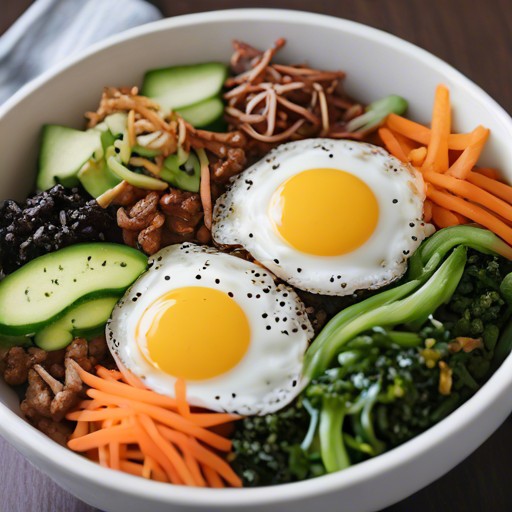Elevate Your Meatless Meals with Vegetarian Bibimbap
Looking to add some excitement to your vegetarian meal repertoire? Look no further than this vibrant and flavorful Vegetarian Bibimbap recipe! Bibimbap, a popular Korean dish, translates to “mixed rice” and is typically made with a variety of vegetables, protein, and a spicy sauce, all served over a bed of rice. In this vegetarian version, we’ve packed in an array of colorful veggies and topped it off with a perfectly cooked egg for a protein boost. Whether you’re a longtime vegetarian or simply looking to incorporate more plant-based meals into your diet, this recipe is sure to become a new favorite. Let’s dive into how to make this delicious dish!
Ingredients
Produce
- 6 oz Bamboo shoots, canned
- 1/2 (14 ounce) can Bean sprouts
- 1 cup Carrot matchsticks
- 1/3 cup Green onions, chopped
- 1 (4.5 ounce) can Mushrooms
- 1 cup Zucchini matchsticks
Refrigerated
- 3 Eggs
Condiments
- 3 tsp Sweet red chili sauce
- 2 tbsp Soy sauce
Pasta & Grains
- 2 cups Rice, cooked and cooled
Baking & Spices
- 1/4 tsp Ground black pepper
- 1/8 tsp Salt
Oils & Vinegars
- 2 tbsp Sesame oil
Dairy
- 1 tbsp Butter
Instructions
Step 1: Prepare the Vegetables
- Drain the canned bamboo shoots and bean sprouts, and set them aside.
- In a large skillet, heat 1 tablespoon of sesame oil over medium heat.
- Add the carrot matchsticks to the skillet and sauté for 2-3 minutes until they begin to soften.
- Add the zucchini matchsticks to the skillet and sauté for an additional 2 minutes.
- Remove the vegetables from the skillet and set them aside.
Step 2: Cook the Mushrooms
- In the same skillet, melt the butter over medium heat.
- Add the canned mushrooms to the skillet and sauté for 4-5 minutes until they are golden brown.
- Season the mushrooms with salt and black pepper, then remove them from the skillet and set them aside.
Step 3: Fry the Eggs
- In the skillet, fry the eggs sunny-side up or over-easy until the whites are set but the yolks are still runny.
Step 4: Assemble the Bibimbap
- Divide the cooked rice among serving bowls.
- Arrange the sautéed vegetables, mushrooms, and bean sprouts on top of the rice.
- Place a fried egg on each bowl of rice and vegetables.
Step 5: Serve
- Drizzle the sweet red chili sauce and soy sauce over the bibimbap.
- Garnish with chopped green onions.
- Serve immediately and enjoy!
Cook Notes and Variations
- Protein Options: Feel free to add your favorite protein to this bibimbap recipe, such as tofu, tempeh, or seitan. Simply cook the protein according to your preference and add it to the dish before serving.
- Spice Level: Adjust the amount of sweet red chili sauce to control the spice level of the dish. Add more sauce for extra heat or reduce it for a milder flavor.
- Additional Toppings: Get creative with your bibimbap toppings! Consider adding sliced avocado, kimchi, or pickled radishes for extra flavor and texture.
Keto and Low-Carb Versions
Keto Version
- Replace the rice with cauliflower rice to reduce the carb content of the dish.
- Use low-carb vegetables such as bell peppers, spinach, and kale in place of higher-carb options like carrots and bamboo shoots.
Low-Carb Version
- Skip the rice altogether and serve the sautéed vegetables and fried egg over a bed of mixed greens for a low-carb option.
- Substitute the sweet red chili sauce with a keto-friendly hot sauce or chili paste to reduce the sugar content of the dish.
Frequently Asked Questions (FAQs)
Q: Can I make this dish ahead of time? A: Yes, you can prepare the components of the bibimbap in advance and assemble them just before serving. Simply store the cooked rice and sautéed vegetables separately in the refrigerator until ready to use.
Q: Is this recipe gluten-free? A: Yes, this Vegetarian Bibimbap recipe is naturally gluten-free. Just be sure to check the labels of your soy sauce and sweet red chili sauce to ensure they are gluten-free.
Q: Can I make this dish vegan? A: Absolutely! Simply omit the fried eggs and use a vegan butter substitute or additional sesame oil for sautéing the vegetables.
Q: What can I serve with bibimbap? A: Bibimbap is often served with a side of kimchi, pickled vegetables, or Korean-style seaweed salad for added flavor and texture.
In conclusion, this Vegetarian Bibimbap recipe is a fantastic option for anyone looking to enjoy a flavorful and satisfying meatless meal. Packed with colorful vegetables, protein-rich eggs, and a delicious sweet and savory sauce, it’s a dish that’s sure to please vegetarians and meat-eaters alike. Whether you’re cooking for a crowd or enjoying a cozy meal at home, this bibimbap recipe is a winner. So why wait? Gather your ingredients and get ready to enjoy a taste of Korea right in your own kitchen!

